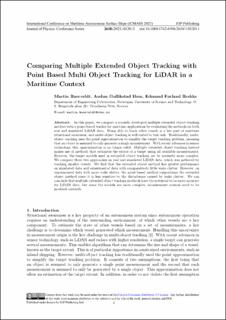| dc.contributor.author | Baerveldt, Martin Lukas | |
| dc.contributor.author | Hem, Audun Gullikstad | |
| dc.contributor.author | Brekke, Edmund Førland | |
| dc.date.accessioned | 2024-01-15T10:19:52Z | |
| dc.date.available | 2024-01-15T10:19:52Z | |
| dc.date.created | 2023-11-28T14:53:18Z | |
| dc.date.issued | 2023 | |
| dc.identifier.issn | 1742-6588 | |
| dc.identifier.uri | https://hdl.handle.net/11250/3111475 | |
| dc.description.abstract | In this paper, we compare a recently developed multiple extended object tracking method with a point-based tracker for maritime applications by evaluating the methods on both real and simulated LiDAR data. Being able to track other vessels is a key part of maritime situational awareness, and multi-object tracking is well suited to this task. Traditionally, multi-object tracking uses the point approximation to simplify the target tracking problem, meaning that an object is assumed to only generate a single measurement. With recent advances in sensor technology, this approximation is no longer valid. Multiple extended object tracking instead makes use of methods that estimates the extent of a target using all available measurements. However, the target models used in extended object tracking are by necessity more complex. We compare these two approaches on real and simulated LiDAR data, which was gathered by tracking smaller vessels. We find that the extended object method has greater performance on simulated data and experimental data with comparatively little wake clutter. However, on experimental data with more wake clutter, the point-based method outperforms the extended object method since it is less sensitive to the disturbance caused by wake clutter. We can conclude that multiple extended object tracking methods have the potential to be more accurate for LiDAR data, but since the models are more complex, measurement sources need to be modeled correctly. | en_US |
| dc.language.iso | eng | en_US |
| dc.rights | Navngivelse 4.0 Internasjonal | * |
| dc.rights.uri | http://creativecommons.org/licenses/by/4.0/deed.no | * |
| dc.title | Comparing Multiple Extended Object Tracking with Point Based Multi Object Tracking for LiDAR in a Maritime Context | en_US |
| dc.title.alternative | Comparing Multiple Extended Object Tracking with Point Based Multi Object Tracking for LiDAR in a Maritime Context | en_US |
| dc.type | Journal article | en_US |
| dc.type | Peer reviewed | en_US |
| dc.description.version | publishedVersion | en_US |
| dc.source.journal | Journal of Physics: Conference Series (JPCS) | en_US |
| dc.identifier.doi | 10.1088/1742-6596/2618/1/012011 | |
| dc.identifier.cristin | 2204133 | |
| dc.relation.project | EC/H2020/955768 | en_US |
| dc.relation.project | Norges forskningsråd: 295033 | en_US |
| dc.relation.project | Norges forskningsråd: 309230 | en_US |
| cristin.ispublished | true | |
| cristin.fulltext | original | |
| cristin.qualitycode | 1 | |

